| Revision as of 13:31, 29 December 2024 editAnitag1980 (talk | contribs)11 edits →Cinema: and →PhotographyTags: Reverted Visual edit← Previous edit | Latest revision as of 18:27, 29 December 2024 edit undoGitz6666 (talk | contribs)Extended confirmed users9,513 edits Undid revision 1265969901 by Anitag1980 (talk)Tag: Undo | ||
| Line 266: | Line 266: | ||
| ===Cinema=== | ===Cinema=== | ||
| Two films have been made about Modigliani: '']'' (1958), directed by ] and starring ] as Modigliani; and '']'' (2004), directed by ] and starring ] as Modigliani. In August 2022, ] directed '']'', which he co-produced alongside ] and Barry Navidi, from a screenplay by Jerzy and Mary Kromolowski.<ref name="Modigliani">{{cite web |url=https://deadline.com/2022/08/johnny-depp-direct-modigliani-al-pacino-amber-heard-1235092154/ |title=Johnny Depp To Direct 'Modigliani', His First Directorial Effort in 25 Years; Al Pacino Co-Producing |website=] |first=Zac |last=Ntim |date=August 15, 2022}}</ref> ] commenced in September 2023.<ref>{{cite web |url=https://variety.com/2023/film/global/johnny-depp-modi-hungary-italy-luisa-ranieri-al-pacino-1235737158/ |title=Johnny Depp Starts Shooting 'Modì' in Hungary, With Italy's Luisa Ranieri Joining Al Pacino and Riccardo Scamarcio in Cast |website=Variety |first=Nick |last=Vivarelli |date=September 27, 2023 |access-date=September 27, 2023}}</ref> | Two films have been made about Modigliani: '']'' (1958), directed by ] and starring ] as Modigliani; and '']'' (2004), directed by ] and starring ] as Modigliani. In August 2022, ] directed '']'', which he co-produced alongside ] and Barry Navidi, from a screenplay by Jerzy and Mary Kromolowski.<ref name="Modigliani">{{cite web |url=https://deadline.com/2022/08/johnny-depp-direct-modigliani-al-pacino-amber-heard-1235092154/ |title=Johnny Depp To Direct 'Modigliani', His First Directorial Effort in 25 Years; Al Pacino Co-Producing |website=] |first=Zac |last=Ntim |date=August 15, 2022}}</ref> ] commenced in September 2023.<ref>{{cite web |url=https://variety.com/2023/film/global/johnny-depp-modi-hungary-italy-luisa-ranieri-al-pacino-1235737158/ |title=Johnny Depp Starts Shooting 'Modì' in Hungary, With Italy's Luisa Ranieri Joining Al Pacino and Riccardo Scamarcio in Cast |website=Variety |first=Nick |last=Vivarelli |date=September 27, 2023 |access-date=September 27, 2023}}</ref> | ||
| There also is an italian short-movie inspired by Amedeo Modigliani. Its title is "''Due giorni d'estate''" ("Two days in summer", 2014) by Luca Dal Canto. It was presented at the 67th ] in the Short Film Corner section and distributed by ], with 33 official selections and 5 awards. | |||
| === Photography === | |||
| is an italian photo project by Luca Dal Canto that has been exposed in Livorno, Pise, Florence, Turin, Marseille, Strasbourg and Paris from 2014 to 2024. | |||
| ==Critical reactions== | ==Critical reactions== | ||
Latest revision as of 18:27, 29 December 2024
Italian painter and sculptor (1884–1920) "Modì" redirects here. For the 2024 biographical film, see Modì, Three Days on the Wing of Madness.
| Amedeo Modigliani | |
|---|---|
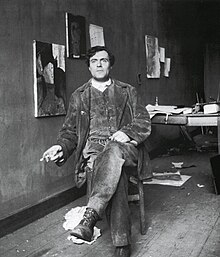 Modigliani c. 1918 Modigliani c. 1918 | |
| Born | (1884-07-12)12 July 1884 Livorno, Kingdom of Italy |
| Died | 24 January 1920(1920-01-24) (aged 35) Paris, France |
| Resting place | Père Lachaise Cemetery |
| Education | Accademia di Belle Arti di Firenze |
| Known for | Painting, sculpture |
| Notable work |
|
| Movement | School of Paris |
| Partner | Jeanne Hébuterne (1917–1920, his death) |
| Children | 4, including Jeanne Modigliani |
| Signature | |
 | |
Amedeo Clemente Modigliani (US: /ˌmoʊdiːlˈjɑːni/; Italian: [ameˈdɛːo modiʎˈʎaːni]; 12 July 1884 – 24 January 1920) was an Italian painter and sculptor of the École de Paris who worked mainly in France. He is known for portraits and nudes in a modern style characterized by a surreal elongation of faces, necks, and figures — works that were not received well during his lifetime, but later became much sought-after. Modigliani spent his youth in Italy, where he studied the art of antiquity and the Renaissance. In 1906, he moved to Paris, where he came into contact with such artists as Pablo Picasso and Constantin Brâncuși. By 1912, Modigliani was exhibiting highly stylized sculptures with Cubists of the Section d'Or group at the Salon d'Automne.
Modigliani's oeuvre includes paintings and drawings. From 1909 to 1914, he devoted himself mainly to sculpture. His main subjects were portraits and full figures, both in the images and in the sculptures. Modigliani had little success while alive but after his death achieved great popularity. He died of tubercular meningitis, at the age of 35, in Paris.
Family and early life
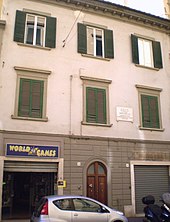
Modigliani was born into a Sephardic Jewish family in Livorno, Italy. A port city, Livorno had long served as a refuge for those persecuted for their religion, and was home to a large Jewish community. His maternal great-great-grandfather, Solomon Garsin, had immigrated to Livorno in the 18th century as a refugee.
Modigliani's mother, Eugénie Garsin, born and raised in Marseille, was descended from an intellectual, scholarly family of Sephardic ancestry that for generations had lived along the Mediterranean coastline. Fluent in many languages, her ancestors were authorities on sacred Jewish texts and had founded a school of Talmudic studies. Family legend traced the family lineage to the 17th-century Dutch philosopher Baruch Spinoza. The family business was money lending, with branches in Livorno, Marseille, Tunis, and London, though their fortunes ebbed and flowed.
Modigliani's father, Flaminio, was a member of an Italian Jewish family of successful businessmen and entrepreneurs. While not as culturally sophisticated as the Garsins, they knew how to invest in and develop thriving business endeavors. When the Garsin and Modigliani families announced the engagement of their children, Flaminio was a wealthy young mining engineer. He managed the mine in Sardinia and also managed the almost 30,000 acres (12,141 ha) of timberland the family owned.
A reversal in fortune occurred to this prosperous family in 1883. An economic downturn in the price of metal plunged the Modiglianis into bankruptcy. Ever resourceful, Modigliani's mother used her social contacts to establish a school and, along with her two sisters, made the school into a successful enterprise.
Amedeo Modigliani was the fourth child, whose birth coincided with the disastrous financial collapse of his father's business interests. Amedeo's birth saved the family from ruin; according to an ancient law, creditors could not seize the bed of a pregnant woman or a mother with a newborn child. The bailiffs entered the family's home just as Eugénie went into labour; the family protected their most valuable assets by piling them on top of her.
Modigliani had a close relationship with his mother, who taught him at home until he was 10. Beset with health problems after an attack of pleurisy when he was about 11, a few years later he developed a case of typhoid fever. When he was 16 he was taken ill again and contracted the tuberculosis which would later claim his life. After Modigliani recovered from the second bout of pleurisy, his mother took him on a tour of southern Italy: Naples, Capri, Rome and Amalfi, then north to Florence and Venice.
His mother was, in many ways, instrumental in his ability to pursue art as a vocation. When he was 11 years of age, she had noted in her diary: "The child's character is still so unformed that I cannot say what I think of it. He behaves like a spoiled child, but he does not lack intelligence. We shall have to wait and see what is inside this chrysalis. Perhaps an artist?"
Art student years
Modigliani is known to have drawn and painted from a very early age, and thought himself "already a painter", his mother wrote, even before beginning formal studies. Despite her misgivings that launching him on a course of studying art would impinge upon his other studies, his mother indulged the young Modigliani's passion for the subject.
At the age of fourteen, while sick with typhoid fever, he raved in his delirium that he wanted, above all else, to see the paintings in the Palazzo Pitti and the Uffizi in Florence. As Livorno's local museum housed only a sparse few paintings by the Italian Renaissance masters, the tales he had heard about the great works held in Florence intrigued him, and it was a source of considerable despair to him, in his sickened state, that he might never get the chance to view them in person. His mother promised that she would take him to Florence herself, the moment he was recovered. Not only did she fulfil this promise, but she also undertook to enroll him with the best painting master in Livorno, Guglielmo Micheli.
Micheli and the Macchiaioli
| This section needs additional citations for verification. Please help improve this article by adding citations to reliable sources in this section. Unsourced material may be challenged and removed. Find sources: "Amedeo Modigliani" – news · newspapers · books · scholar · JSTOR (July 2017) (Learn how and when to remove this message) |
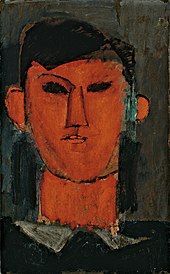

Modigliani worked in Micheli's Art School from 1898 to 1900. Among his colleagues in that studio would have been Llewelyn Lloyd, Giulio Cesare Vinzio, Manlio Martinelli, Gino Romiti, Renato Natali, and Oscar Ghiglia. Here his earliest formal artistic instruction took place in an atmosphere steeped in a study of the styles and themes of 19th-century Italian art. In his earliest Parisian work, traces of this influence, and that of his studies of Renaissance art, can still be seen. His nascent work was influenced by such Parisian artists as Giovanni Boldini and Toulouse-Lautrec.
Modigliani showed great promise while with Micheli, and ceased his studies only when he was forced to, by the onset of tuberculosis.
In 1901, whilst in Rome, Modigliani admired the work of Domenico Morelli, a painter of dramatic religious and literary scenes. Morelli had served as an inspiration for a group of iconoclasts who were known by the title "the Macchiaioli" (from macchia —"dash of colour", or, more derogatively, "stain"), and Modigliani had already been exposed to the influences of the Macchiaioli. This localized landscape movement reacted against the bourgeois stylings of the academic genre painters. While sympathetically connected to (and actually pre-dating) the French Impressionists, the Macchiaioli did not make the same impact upon international art culture as did the contemporaries and followers of Monet, and are today largely forgotten outside Italy.
Modigliani's connection with the movement was through Guglielmo Micheli, his first art teacher. Micheli was not only a Macchiaiolo himself, but had been a pupil of the famous Giovanni Fattori, a founder of the movement. Micheli's work, however, was so fashionable and the genre so commonplace that the young Modigliani reacted against it, preferring to ignore the obsession with landscape that, as with French Impressionism, characterized the movement. Micheli also tried to encourage his pupils to paint en plein air, but Modigliani never really got a taste for this style of working, sketching in cafés, but preferring to paint indoors, and especially in his own studio. Even when compelled to paint landscapes (three are known to exist), Modigliani chose a proto-Cubist palette more akin to Cézanne than to the Macchiaioli.
While with Micheli, Modigliani studied not only landscape, but also portraiture, still life, and the nude. His fellow students recall that the last was where he displayed his greatest talent, and apparently this was not an entirely academic pursuit for the teenager: when not painting nudes, he was occupied with seducing the household maid.
Despite his rejection of the Macchiaioli approach, Modigliani nonetheless found favour with his teacher, who referred to him as "Superman", a pet name reflecting the fact that Modigliani was not only quite adept at his art, but also that he regularly quoted from Nietzsche's Thus Spoke Zarathustra. Fattori himself would often visit the studio, and approved of the young artist's innovations.
In 1902, Modigliani continued what was to be a lifelong infatuation with life drawing, enrolling in the Scuola Libera di Nudo, or "Free School of Nude Studies", of the Accademia di Belle Arti in Florence. A year later, while still suffering from tuberculosis, he moved to Venice, where he registered to study at the Regia Accademia ed Istituto di Belle Arti. It is in Venice that he first smoked hashish and, rather than studying, began to spend time frequenting disreputable parts of the city. The impact of these lifestyle choices upon his developing artistic style is open to conjecture, although these choices do seem to be more than simple teenage rebellion, or the clichéd hedonism and bohemianism that was almost expected of artists of the time; his pursuit of the seedier side of life appears to have roots in his appreciation of radical philosophies, including those of Nietzsche.
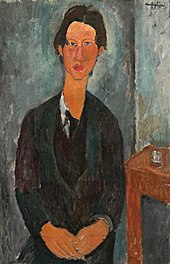
Early literary influences
Having been exposed to erudite philosophical literature as a young boy under the tutelage of Isaco Garsin, his maternal grandfather, he continued to read and be influenced through his art studies by the writings of Nietzsche, Baudelaire, Carducci, Comte de Lautréamont, and others, and developed the belief that the only route to true creativity was through defiance and disorder.
Letters that he wrote from his 'sabbatical' in Capri in 1901 clearly indicate that he is being more and more influenced by the thinking of Nietzsche. In these letters, he advised friend Oscar Ghiglia;
(hold sacred all) which can exalt and excite your intelligence... (and) ... seek to provoke ... and to perpetuate ... these fertile stimuli, because they can push the intelligence to its maximum creative power.
The work of Lautréamont was equally influential at this time. This doomed poet's Les Chants de Maldoror became the seminal work for the Parisian Surrealists of Modigliani's generation, and the book became Modigliani's favourite to the extent that he learnt it by heart. The poetry of Lautréamont is characterized by the juxtaposition of fantastical elements, and by sadistic imagery; the fact that Modigliani was so taken by this text in his early teens gives a good indication of his developing tastes. Baudelaire and D'Annunzio similarly appealed to the young artist, with their interest in corrupted beauty, and the expression of that insight through Symbolist imagery.
Modigliani wrote to Ghiglia extensively from Capri, where his mother had taken him to assist in his recovery from tuberculosis. These letters are a sounding board for the developing ideas brewing in Modigliani's mind. Ghiglia was seven years Modigliani's senior, and it is likely that it was he who showed the young man the limits of his horizons in Livorno. Like all precocious teenagers, Modigliani preferred the company of older companions, and Ghiglia's role in his adolescence was to be a sympathetic ear as he worked himself out, principally in the convoluted letters that he regularly sent, and which survive today.
Dear friend, I write to pour myself out to you and to affirm myself to myself. I am the prey of great powers that surge forth and then disintegrate ... A bourgeois told me today–insulted me–that I or at least my brain was lazy. It did me good. I should like such a warning every morning upon awakening: but they cannot understand us nor can they understand life...
Paris
Arrival

In 1906, Modigliani moved to Paris, then the focal point of the avant-garde. In fact, his arrival at the centre of artistic experimentation coincided with the arrival of two other foreigners who were also to leave their marks upon the art world: Gino Severini and Juan Gris.
He later befriended Jacob Epstein, with whom he aimed to set up a studio or Temple of Beauty to be enjoyed by all. Modigliani himself intended to create the drawings and paintings of the stone caryatids for 'The Pillars of Tenderness' which would support the imagined temple.

Modigliani squatted in the Bateau-Lavoir, a commune for penniless artists in Montmartre, renting himself a studio in Rue Caulaincourt. Even though this artists' quarter of Montmartre was characterized by generalized poverty, Modigliani himself presented—initially, at least—as one would expect the son of a family trying to maintain the appearances of its lost financial standing to present: his wardrobe was dapper without ostentation, and the studio he rented was appointed in a style appropriate to someone with a finely attuned taste in plush drapery and Renaissance reproductions. He soon made efforts to assume the guise of the bohemian artist, but, even in his brown corduroys, scarlet scarf and large black hat, he continued to appear as if he were slumming it, having fallen upon harder times.
When he first arrived in Paris, he wrote home regularly to his mother, sketched his nudes at the Académie Colarossi, and drank wine in moderation. At that time, he was considered, by those who knew him, to be a bit reserved, verging on the asocial, and is noted to have commented, upon meeting Picasso, who at the time was wearing his trademark workmen's clothes, that even though the man was a genius, that did not excuse his uncouth appearance.
Transformation
Within a year of arriving in Paris, however, his demeanour and reputation had changed dramatically. He transformed himself from a dapper academician artist into a sort of prince of vagabonds.
The poet and journalist Louis Latourette, upon visiting the artist's previously well-appointed studio after his transformation, discovered the place in upheaval, the Renaissance reproductions discarded from the walls, the plush drapes in disarray. Modigliani was already an alcoholic and a drug addict by this time, and his studio reflected this. Modigliani's behaviour at this time sheds some light upon his developing style as an artist, in that the studio had become almost a sacrificial effigy for all that he resented about the academic art that had marked his life and his training up to that point.
Not only did he remove all the trappings of his bourgeois heritage from his studio, but he also set about destroying practically all of his own early work, which he described as "Childish baubles, done when I was a dirty bourgeois".
The motivation for this violent rejection of his earlier self is the subject of considerable speculation. From the time of his arrival in Paris, Modigliani consciously crafted a charade persona for himself and cultivated his reputation as a hopeless drunk and voracious drug user. His escalating intake of drugs and alcohol may have been a means by which Modigliani masked his tuberculosis from his acquaintances, few of whom knew of his condition. Tuberculosis—the leading cause of death in France by 1900—was highly communicable, there was no cure, and those who had it were feared, ostracized, and pitied. Modigliani thrived on camaraderie and would not let himself be isolated as an invalid; he used drink and drugs as palliatives to ease his physical pain, helping him to maintain a façade of vitality and allowing him to continue to create his art.
Modigliani's use of drink and drugs intensified from about 1914 onward. After years of remission and recurrence, this was the period during which the symptoms of his tuberculosis worsened, signaling that the disease had reached an advanced stage.

He sought the company of artists such as Utrillo and Soutine, seeking acceptance and validation for his work from his colleagues. Modigliani's behavior stood out even in these Bohemian surroundings: he carried on frequent affairs, drank heavily, and used absinthe and hashish. While drunk, he would sometimes strip himself naked at social gatherings. He died in Paris, aged 35. He became the epitome of the tragic artist, creating a posthumous legend almost as well known as that of Vincent van Gogh.
During the 1920s, in the wake of Modigliani's career and spurred on by comments by André Salmon crediting hashish and absinthe with the genesis of Modigliani's style, many hopefuls tried to emulate his "success" by embarking on a path of substance abuse and bohemian excess. Salmon claimed that whereas Modigliani was a totally pedestrian artist when sober, "...from the day that he abandoned himself to certain forms of debauchery, an unexpected light came upon him, transforming his art. From that day on, he became one who must be counted among the masters of living art."
Some art historians suggest that it is entirely possible that Modigliani would have achieved even greater artistic heights had he not been immured in, and destroyed by, his own self-indulgences.
Output
During his early years in Paris, Modigliani worked at a furious pace. He was constantly sketching, making as many as a hundred drawings a day. However, many of his works were lost—destroyed by him as inferior, left behind in his frequent changes of address, or given to girlfriends who did not keep them.
He was first influenced by Henri de Toulouse-Lautrec, but around 1907 he became fascinated with the work of Paul Cézanne. Eventually he developed his own unique style, one that cannot be adequately categorized with those of other artists.
He met the first serious love of his life, Russian poet Anna Akhmatova, in 1910, when he was 26. They had studios in the same building, and although 21-year-old Anna had recently married, they began an affair. Anna was tall with dark hair, pale skin and grey-green eyes: she embodied Modigliani's aesthetic ideal and the pair became engrossed in each other. After a year, however, Anna returned to her husband.
Gallery of works
-
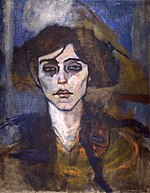 Portrait of Maude Abrantes, 1907, Hecht Museum
Portrait of Maude Abrantes, 1907, Hecht Museum
-
 The Cellist, 1909, Juan Abelló Collection
The Cellist, 1909, Juan Abelló Collection
-
 Paul Guillaume, Novo Pilota, 1915, Musée de l'Orangerie
Paul Guillaume, Novo Pilota, 1915, Musée de l'Orangerie
-
 Bride and Groom, 1915
Bride and Groom, 1915
-
 Portrait of Moise Kisling, 1915
Portrait of Moise Kisling, 1915
-
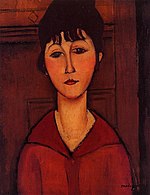 Head of a Young Girl, 1916, Private Collection of Matvey Yozhikov
Head of a Young Girl, 1916, Private Collection of Matvey Yozhikov
-
Portrait of the painter Manuel Humbert, 1916, National Gallery of Victoria
-
 Jacques and Berthe Lipchitz, 1916
Jacques and Berthe Lipchitz, 1916
-
 Léon Indenbaum, 1916, Henry and Rose Pearlman Collection, on long-term loan to the Princeton University Art Museum
Léon Indenbaum, 1916, Henry and Rose Pearlman Collection, on long-term loan to the Princeton University Art Museum
-
 Portrait of Beatrice Hastings, 1916
Portrait of Beatrice Hastings, 1916
-
 Madame Kisling, 1917
Madame Kisling, 1917
-
 Portrait of Blaise Cendrars, 1917, Galleria Sabauda, Turin
Portrait of Blaise Cendrars, 1917, Galleria Sabauda, Turin
-
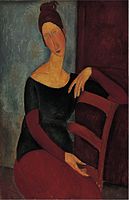 Portrait of the Artist's Wife (Jeanne Hébuterne), 1918
Portrait of the Artist's Wife (Jeanne Hébuterne), 1918
-
 Jeanne Hébuterne with Yellow Sweater, 1918
Jeanne Hébuterne with Yellow Sweater, 1918
-
 The Little Peasant, 1918, Tate Liverpool
The Little Peasant, 1918, Tate Liverpool
-
 Dedie Hayden, 1918, Centre Georges Pompidou
Dedie Hayden, 1918, Centre Georges Pompidou
-
 Portrait of a Young Woman, 1918, New Orleans Museum of Art
Portrait of a Young Woman, 1918, New Orleans Museum of Art
-
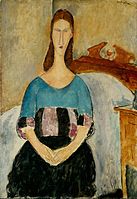 Portrait of Jeanne Hebuterne, Seated, 1918, Israel Museum, Jerusalem
Portrait of Jeanne Hebuterne, Seated, 1918, Israel Museum, Jerusalem
-
 Beatrice Hastings, 1916–1919, Solomon R. Guggenheim Museum
Beatrice Hastings, 1916–1919, Solomon R. Guggenheim Museum
-
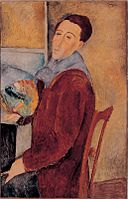 Self-portrait, 1919, oil on canvas, Museum of Contemporary Art, São Paulo
Self-portrait, 1919, oil on canvas, Museum of Contemporary Art, São Paulo
-
 Gypsy Woman with Baby, 1919, National Gallery of Art
Gypsy Woman with Baby, 1919, National Gallery of Art
-
 Buste de femme, unknown, before 1919, Museo Nacional de Bellas Artes (Buenos Aires)
Buste de femme, unknown, before 1919, Museo Nacional de Bellas Artes (Buenos Aires)
-
 Woman with a Fan, 1919, stolen from Musée d'Art Moderne de la Ville de Paris
Woman with a Fan, 1919, stolen from Musée d'Art Moderne de la Ville de Paris
-
 Portrait of a man, 1918, private collector
Portrait of a man, 1918, private collector
Montparnasse, Paris

Sculpture

In 1909, Modigliani returned home to Livorno, sickly and tired from his wild lifestyle. But soon he was back in Paris, this time renting a studio in Montparnasse. He originally saw himself as a sculptor rather than a painter, and was encouraged to continue after Paul Guillaume, an ambitious young art dealer, took an interest in his work and introduced him to sculptor Constantin Brâncuși. He was Constantin Brâncuși's disciple for one year.
Although a series of Modigliani's sculptures were exhibited in the Salon d'Automne of 1912, by 1914 he abandoned sculpting and focused solely on his painting, a move precipitated by the difficulty in acquiring sculptural materials due to the outbreak of war, and by Modigliani's physical debilitation.
In June 2010 Modigliani's Tête, a limestone carving of a woman's head, became the third most expensive sculpture ever sold.
Friends and influences
Modigliani painted a series of portraits of contemporary artists and friends in Montparnasse: Chaïm Soutine, Moïse Kisling, Pablo Picasso, Diego Rivera, Marie "Marevna" Vorobyev-Stebeslka, Juan Gris, Max Jacob, Jacques Lipchitz, Blaise Cendrars, and Jean Cocteau, all sat for stylized renditions. Modigliani painted Soutine's portrait several times, when they lived together in the Cité Falguière around 1916.
War years
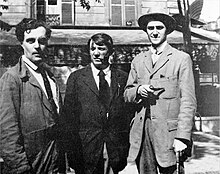
At the outset of World War I, Modigliani tried to enlist in the army but was refused because of his poor health.
Known as Modì (which plays on the French word 'maudit', meaning 'cursed') by many Parisians, but as Dedo to his family and friends, Modigliani was a handsome man, and attracted much female attention. Women came and went until Beatrice Hastings entered his life. She stayed with him for almost two years, was the subject of several of his portraits, including Madame Pompadour, and the object of much of his drunken wrath.
When the British painter Nina Hamnett arrived in Montparnasse in 1914, on her first evening there the smiling man at the next table in the café introduced himself as "Modigliani, painter and Jew". They became great friends.
In 1916, Modigliani befriended the Polish poet and art dealer Léopold Zborowski and his wife Anna. Zborowski became Modigliani's primary art dealer and friend during the artist's final years, helping him financially, and also organizing his show in Paris in 1917.
Patronage of Léopold Zborowski

1917 Paris Show
The several dozen nudes Modigliani painted between 1916 and 1919 constitute many of his best-known works. This series of nudes was commissioned by Modigliani's dealer and friend Léopold Zborowski, who lent the artist use of his apartment, supplied models and painting materials, and paid him between fifteen and twenty francs each day for his work.
The paintings from this arrangement were thus different from his previous depictions of friends and lovers in that they were funded by Zborowski either for his own collection, as a favor to his friend, or with an eye to their "commercial potential", rather than originating from the artist's personal circle of acquaintances.
The Paris show of 1917 was Modigliani's only solo exhibition during his life, and is "notorious" in modern art history for its sensational public reception and the attendant issues of obscenity. The show was closed by police on its opening day, but continued thereafter, most likely after the removal of paintings from the gallery's streetfront window.
Nude Sitting on a Divan is one of a series of nudes painted by Modigliani in 1917 that created a sensation when exhibited in Paris that year. According to the catalogue description from the 2010 sale of the painting at Sotheby's, seven nudes were exhibited in the 1917 show.
Nu couché realized $170,405,000 at a Christie's, New York, sale on 9 November 2015, a record for a Modigliani painting and placing it high among the most expensive paintings ever sold.
- Nudes
-
 Iris Tree, c. 1916, Courtauld Institute of Art
Iris Tree, c. 1916, Courtauld Institute of Art
-
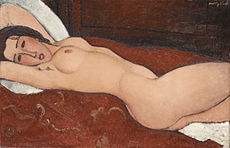 Reclining Nude, 1917, Metropolitan Museum of Art
Reclining Nude, 1917, Metropolitan Museum of Art
-
 Seated Nude, 1917, Royal Museum of Fine Arts Antwerp
Seated Nude, 1917, Royal Museum of Fine Arts Antwerp
-
 Nude, 1917, Solomon R. Guggenheim Museum
Nude, 1917, Solomon R. Guggenheim Museum
-
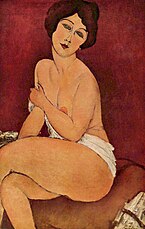 Nude Sitting on a Divan ("La Belle Romaine"), 1917
Nude Sitting on a Divan ("La Belle Romaine"), 1917
-
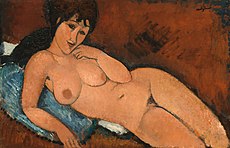 Nude on a Blue Cushion, 1917, National Gallery of Art
Nude on a Blue Cushion, 1917, National Gallery of Art
-
 Nu couché, 1917–18, sold for $170.4 million in 2015 to Liu Yiqian
Nu couché, 1917–18, sold for $170.4 million in 2015 to Liu Yiqian
-
 Seated Nude, 1918, Honolulu Museum of Art
Seated Nude, 1918, Honolulu Museum of Art
-
 Nu couché (sur le côté gauche), 1917
Nu couché (sur le côté gauche), 1917
Nice
On a trip to Nice which had been conceived and organized by Zborowski, Modigliani, Foujita and other artists tried to sell their works to rich tourists. Modigliani managed to sell a few pictures, but only for a few francs each. Despite this, during this time he produced most of the paintings that later became his most popular and valued works.
During his lifetime, he sold a number of his works, but never for any great amount of money. What funds he did receive soon vanished for his habits.
Jeanne Hébuterne
| This section needs additional citations for verification. Please help improve this article by adding citations to reliable sources in this section. Unsourced material may be challenged and removed. (November 2021) (Learn how and when to remove this message) |

In the spring of 1917, the Russian sculptor Chana Orloff introduced him to a 19-year-old art student named Jeanne Hébuterne who had posed for Tsuguharu Foujita. From a conservative bourgeois background, Hébuterne was renounced by her devout Roman Catholic family for her liaison with Jewish Modigliani, whom they saw as little more than a debauched derelict. Despite her family's objections, soon they were living together.

Modigliani ended his relationship with the English poet and art critic Beatrice Hastings. A short time later Hébuterne and Modigliani moved together into a studio on the Rue de la Grande Chaumière. Jeanne began to pose for him and appears in several of his paintings. Jeanne Hébuterne became a principal subject for Modigliani's art.
Towards the end of the First World War, early in 1918, Modigliani left Paris with Hébuterne to escape from the war and travelled to Nice and Cagnes-sur-Mer. They would spend a year in France. During that time they had a busy social life with many friends, including Pierre-Auguste Renoir, Pablo Picasso, Giorgio de Chirico and André Derain.

After he and Hébuterne moved to Nice on 29 November 1918, she gave birth to a daughter whom they named Jeanne (1918–1984). Modigliani already had a son from his relationship with Simone Thiroux, Gérard Thiroux (1917–2004), and at least two other extramarital children. In May 1919 they returned to Paris with their infant daughter and moved into an apartment on the rue de la Grande Chaumière.
Hébuterne became pregnant again. Modigliani then got engaged to her, but Jeanne's parents were against the marriage, especially because of Modigliani's reputation as an alcoholic and drug user. However, Modigliani officially recognized her daughter as his child. The wedding plans were shattered independently of Jeanne's parents' resistance when Modigliani discovered he had a severe form of tuberculosis.
Death and funeral
| This section needs additional citations for verification. Please help improve this article by adding citations to reliable sources in this section. Unsourced material may be challenged and removed. (November 2021) (Learn how and when to remove this message) |
Although he continued to paint, Modigliani's health deteriorated rapidly, and his alcohol-induced blackouts became more frequent.
In 1920, after not hearing from him for several days, a neighbour checked on the family and found Modigliani in bed delirious and holding onto Hébuterne. A doctor was summoned, but little could be done because Modigliani was in the final stage of his disease, tubercular meningitis. He died on 24 January 1920, at the Hôpital de la Charité.
There was an enormous funeral, attended by many from the artistic communities in Montmartre and Montparnasse. When Modigliani died, 21-year-old Hébuterne was eight months pregnant with their second child. The day after Modigliani's death, Hébuterne was taken to her parents' home. There, inconsolable, she threw herself out of a fifth-floor window, killing herself and her unborn child.
Modigliani was buried in Père Lachaise Cemetery. Hébuterne was buried at the Cimetière de Bagneux near Paris, and it was not until 1930 that her embittered family allowed her body to be moved to rest beside Modigliani. A single tombstone honors them both. His epitaph reads: "Struck down by death at the moment of glory". Hers reads: "Devoted companion to the extreme sacrifice".
Managing only one solo exhibition in his life and giving his work away in exchange for meals in restaurants, Modigliani died destitute.
Legacy

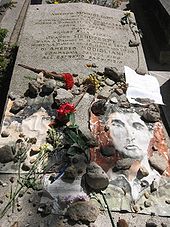
Influences
The linear form of African sculpture and the depictive humanism of the figurative Renaissance painters informed his work. Working during that fertile period of "isms", Cubism, Dadaism, Surrealism, Futurism, Modigliani did not choose to be categorized within any of these prevailing, defining confines. He was unclassifiable, stubbornly insisting on his difference. He was an artist putting down paint on canvas and creating works not to shock and outrage, but to say, "This is what I see."
More appreciated over the years by collectors than academicians and critics, Modigliani was indifferent to staking a claim for himself in the intellectual avant-garde of the art world. One can say he recognized the merit of Jean Cocteau's proclamation: "Ne t'attardes pas avec l'avant-garde" ("Don't wait with the avant-garde"). Pseudo-goitre, a medical condition, is also known as Modigliani syndrome. This name was derived from the curved neck of women in Modigliani's paintings which appeared like pseudogoitre.
Since his death, Modigliani's reputation has soared. Nine novels, a play, a documentary, and three feature films have been devoted to his life. Modigliani's sister in Florence adopted his daughter, Jeanne (1918–1984). As an adult, she wrote a biography of her father titled Modigliani: Man and Myth.
Catalogues raisonnés
The Modigliani estate is one of the most problematic in the art world. There are at least five catalogues raisonnés of the artist's work including two volumes by Ambrogio Ceroni, last updated in 1972. Arthur Pfannstiel (1929 and 1956) and Joseph Lanthemann's (1970) books are widely dismissed today. Milanese scholar Osvaldo Patani produced three volumes: paintings (1991), drawings (1992) and one on the Paul Alexandre period (1994), while Christian Parisot has published Volumes I, II and IV (in 1970, 1971 and 1996) of a catalogue raisonné.
In 2006, about 6,000 documents from the estate—believed to be the only ones existing—were moved permanently from France to Italy. Parisot, as president of the Modigliani Institut Archives Légales in Rome, had the legal right to authenticate Modigliani's work. In 2013, Parisot was arrested by the Italian Art forgery unit after a two-year investigation (following a largely advertised exhibition in Catania, presenting original artworks); the police seized works attributed to the artist, along with suspect authenticity certificates.
The French art historian Marc Restellini is preparing Modigliani's catalogue raisonné.
The Modigliani Project, headed by Dr. Kenneth Wayne, was founded in 2012 to aid in the researching of Modigliani artworks. As part of this endeavor the organization is preparing a new catalogue raisonné of Modigliani's artwork.
Art market
In November 2010, a painting of a nude by Amedeo Modigliani, part of a series of nudes he created around 1917, sold for more than $68.9m (£42.7m) at an auction in New York—a record for the artist's work. Bidding for La Belle Romaine pushed its price well past its $40m (£24.8m) estimate. Modigliani's previous auction record was 43.2m euros (£35.8m), set earlier in 2010 in Paris. Another painting by the artist—Jeanne Hébuterne (au chapeau), one of the first portraits he painted of his lover—sold for $19.1m (£11.8m), much higher than its pre-sale estimate of $9–12m (£5.6–7.4m).
On 9 November 2015 the 1917 painting Nu couché, sold at Christie's in New York for US$170.4 million. On 14 May 2018 the 1917 painting Nu couché (sur le côté gauche) sold at Sotheby's in New York for $157.2 million. This was the highest auction price in Sotheby's history.
Forgeries
Modigliani is one of the most faked artists in the world. Rising prices for works attributed to him as well as the legend surrounding his short life have fueled a market for forgeries of both paintings and sculptures. In 1984, students carved three stone heads in a Modigliani style, causing a sensation when they were "discovered" in a canal in Livorno, Italy. Experts claimed they were authentic until the students released a video they had filmed of themselves making the heads with a Black and Decker drill. In 2018 twenty fake Modiglianis were seized at an exhibition in Genoa. Famous art forgers such as Elmyr de Hory admitted to creating many fake Modiglianis. Experienced art dealers such as Klaus Perls were tricked into purchasing fake Modigliani statues. It has been estimated that most artworks attributed to Modigliani are actually forgeries.
Cinema
Two films have been made about Modigliani: Les Amants de Montparnasse (1958), directed by Jacques Becker and starring Gérard Philipe as Modigliani; and Modigliani (2004), directed by Mick Davis and starring Andy García as Modigliani. In August 2022, Johnny Depp directed Modì, Three Days on the Wing of Madness, which he co-produced alongside Al Pacino and Barry Navidi, from a screenplay by Jerzy and Mary Kromolowski. Principal photography commenced in September 2023.
Critical reactions
In 2011, Peter Schjeldahl, reviewing Meryle Secrest's book Modigliani: A Life, wrote:
I recall my thrilled first exposure, as a teenager, to one of his long-necked women, with their piquantly tipped heads and mask-like faces. The rakish stylization and the succulent color were easy to enjoy, and the payoff was sanguinely erotic in a way that endorsed my personal wishes to be bold and tender and noble, overcoming the wimp that I was. In that moment, I used up Modigliani's value for my life. But in museums ever since I have been happy to salute his pictures with residually grateful, quick looks.
Schjeldahl reports Secrest's speculation that Modigliani was happy to let people consider him an alcoholic and drug addict, "and thus to mistake the symptoms of his tuberculosis, which he kept a secret. Drunks were tolerated; carriers of infectious diseases were not."
Selected works

Paintings
- Head of a Woman with a Hat (1907)
- Portrait of Juan Gris (1915)
- Portrait of Pablo Picasso (1915)
- Portrait of the Art Dealer Paul Guillaume (1916)
- Portrait of Jean Cocteau (1916)
- Jeanne Hébuterne with Hat and Necklace (1917)
- Nu couché (1917-1918)
- Seated Nude (c. 1918), Honolulu Museum of Art
- Portrait of Jeanne Hébuterne (1918)
- Jeanne Hébuterne aux épaules nues (1919)
- Woman with a Fan (1919), stolen from the Paris Modern Art Museum on 19 May 2010 and portrayed in the films Trance and Skyfall
- Portrait of Marios Varvoglis (1920; Modigliani's last painting)
Sculptures
Twenty-seven sculptures by Modigliani are known to exist.
- Tête (1910/1912)
- Head of a Woman (1910/1911).
- Head (1911–1913).
- Head (1911–1912).
- Head (1912).
- Rose Caryatid (1914).
Selected exhibitions
- 1907 (October): 5th Salon d'automne, Grand Palais, Paris
- 1908 (October): 24th Salon des Independants, Paris
- 1910 (March–May): 26th Salon des Independants, Paris
- 1914 (20 May – 8 June): Whitechapel art gallery: 20th century art (a review of modern movements), London
- 1917 (3–30 December): Solo exhibition, Galerie Berthe Weill, Paris
See also
- Nude Sitting on a Divan
- Nu couché
- Seated Man with a Cane
- Lille Métropole Museum of Modern, Contemporary and Outsider Art
- Painting the Century: 101 Portrait Masterpieces 1900–2000
- Hilla Rebay
References
- "Heroes – Trailblazers of the Jewish People". Beit Hatfutsot. Archived from the original on 30 August 2019.
- Werner, Alfred (1967). Amedeo Modigliani. London: Thames and Hudson. p. 13. ISBN 0-8109-0323-7.
- Secrest, Modigilani, Alfred Knopf, 2011, pp. 16–18
- ^ "Klein, Mason, et al., Modigliani: Beyond the Myth, page 197. The Jewish Museum and Yale University Press, 2004". Archived from the original on 22 October 2014. Retrieved 14 September 2014.
- Secrest (2011), Modigilani,pp. 24–25
- Secrest (2011), Modigilani, pp. 34–35
- Fifield, William (19 June 1978). Modigliani: A Biography. W.H. Allen. p. 316. ISBN 0-491-02164-X.
- Diehl, Gaston (July 1989). Modigliani (Reissue ed.). Crown Pub. p. 96. ISBN 0-517-50798-6.
- Soby, James Thrall (September 1977). Amedeo Modigliani. New York: Arno P. p. 55.
- Werner, Alfred (1967). Amedeo Modigliani. London: Thames and Hudson. p. 14. ISBN 0-8109-0323-7.
- ^ Mann, Carol (1980). Modigliani. London: Thames and Hudson. p. 12. ISBN 0-500-20176-5.
- Werner, Alfred (1967). Amedeo Modigliani. London: Thames and Hudson. p. 16. ISBN 0-8109-0323-7.
- ^ Mann, Carol (1980). Modigliani. London: Thames and Hudson. p. 16. ISBN 0-500-20176-5.
- ^ Werner, Alfred (1967). Amedeo Modigliani. London: Thames and Hudson. p. 17. ISBN 0-8109-0323-7.
- Mann, Carol (1980). Modigliani. London: Thames and Hudson. pp. 19–22. ISBN 0-500-20176-5.
- Mann, Carol (1980). Modigliani. London: Thames and Hudson. p. 20. ISBN 0-500-20176-5.
- "Modigliani Caryatid Drawings". The New Art Gallery Walsall Catalogue. The New Art Gallery Walsall. Archived from the original on 7 July 2013. Retrieved 16 May 2013.
- "Modigliani Caryatid Drawings". The New Art Gallery Walsall. Archived from the original on 7 July 2013. Retrieved 16 June 2013.
- ^ Werner, Alfred (1967). Amedeo Modigliani. London: Thames and Hudson. p. 19. ISBN 0-8109-0323-7.
- Secrest, Meryle, Modigliani, Alfred A. Knopf, 2011, p. 181, 183
- Secrest, Meryle, Modigliani, Alfred A. Knopf, 2011, p. 181
- Secrest, Meryle, Modigliani, Alfred A. Knopf, 2011, p. 298
- Secrest, Meryle, Modigliani, Alfred A. Knopf, 2011, p. 182
- "Women in Art, PDF" (PDF). shareholder.com. Retrieved 7 September 2018.
- ^ Werner, Alfred (1985). Amedeo Modigliani. New York: Harry N. Abrams, Inc. p. 24. ISBN 0-8109-1416-6.
- ^ Werner, Alfred (1967). Amedeo Modigliani. London: Thames and Hudson. p. 20. ISBN 0-8109-0323-7.
- "Modigliani and the Russian beauty: the affair that changed him" Retrieved 21 July 2015
- Secrest, Meryle, Modigliani, Knopf Doubleday Publishing Group, 2011, p. 136, ISBN 0307595471
- Dan Franck, Bohemian Paris: Picasso, Modigliani, Matisse, and the Birth of Modern Art, Open Road, Grove/Atlantic, 2007, ISBN 080219740X
- Fiorella Nicosia, Amedeo Modigliani, Modigliani, Taylor & Francis, 2005, pp. 38, 74, ISBN 8809042077
- ^ Ntim, Zac (15 August 2022). "Johnny Depp To Direct 'Modigliani', His First Directorial Effort in 25 Years; Al Pacino Co-Producing". Deadline Hollywood.
- "Amedeo Modigliani". The Israel Museum. Jerusalem: Harry N. Abrams, Inc. 2010. Retrieved 26 October 2022.
- hoakley (13 May 2020). "The short lives of Modigliani and his dealers". The Eclectic Light Company. Retrieved 23 June 2024.
- Klein, Mason, et al., 61–62
- Klein, Mason, et al., 62–63
- ^ Klein, Mason, et al., 56
- Robin Pgrebin and Scott Reyburn (10 November 2015). "With $170.4 Million Sale at Auction, Modigliani Work Joins Rarefied Nine-Figure Club". The New York Times.
- Connor, Neil (10 November 2015). "Meet the Chinese billionaire behind the record Amedeo Modigliani purchase". Daily Telegraph. Archived from the original on 12 January 2022. Retrieved 10 November 2015.
- "Amedeo Modigliani Biography, Art, and Analysis of Works". The Art Story. Retrieved 27 January 2017.
- "Photo". Museo Thyssen – Bornemisza. Archived from the original on 29 February 2008. Retrieved 8 June 2009.
- Secrest, Meryle (1 March 2011). Modigliani. Knopf Doubleday Publishing Group. ISBN 978-0-307-59547-8.
- Harris, James C. (2005). "Jeanne Hébuterne". Archives of General Psychiatry. 62 (7): 710. doi:10.1001/archpsyc.62.7.710. PMID 15997010.
- Lappin, Linda (22 June 2002). "Missing person in Montparnasse: The case of Jeanne Hebuterne". Literary Review. 45 (4): 785–811. Archived from the original on 10 June 2014.
- Secrest, Meryle, Modigliani, Alfred A. Knopf, 2011, pp. 346–47
- Burch M, Warner (3 July 2008). 100 Questions and Answers about thyroid disorders. Jones and Bartlett Publications. ISBN 9781449630836. Retrieved 14 December 2016.
- Georgina Adam (15 May 2002), Pushkin accused of displaying a fake Forbes magazine.
- Sophia Kishkovsky (10 November 2011), Pushkin accused of displaying a fake The Art Newspaper.
- "La Mostra Dei Falsi Modigliani del Duo Ferrera-Stancanelli". Sudpress (in Italian). 19 December 2012. Retrieved 11 June 2020.
- Gareth Harris (24 January 2013), Fake Modiglianis Poison Art Market Archived 18 August 2012 at the Wayback Machine The Art Newspaper.
- ^ Boucher, Brian (22 July 2016). "Despite Death Threats, Modigliani Expert To Publish New Catalogue Raisonné". Artnet. Retrieved 2 March 2019.
- "About Us". The Modigliani Project. Archived from the original on 6 March 2019. Retrieved 2 March 2019.
- "Modigliani nude sells for a record $68.9m". BBC News. 3 November 2010.
- Pogrebin, Robin; Reyburn, Scott (9 November 2015). "With $170.4 Million Sale at Auction, Modigliani Work Joins Rarefied Nine-Figure Club". The New York Times.
- $157 Million for a Modigliani Raises Hardly Any Eyebrows, The New York Times, 14 May 2018
- Esterow, Milton (1 June 2005). "The 10 Most Faked Artists". ARTnews.com. Retrieved 20 March 2021.
- "The dangerous, fake-riddled world of Modiglianis". www.theartnewspaper.com. 30 April 2002. Archived from the original on 28 September 2020. Retrieved 26 May 2021.
There are no less than five different reference works on the artist. The most respected is that by Ambrogio Ceroni, whose 1958, 1970 and 1972 tomes remain the only reliable works, according to leading dealers and auction houses. Arthur Pfannstiel (1929 and 1956) and Joseph Lanthemann's (1970) books are dismissed today. The Milanese scholar Osvaldo Patani has produced three volumes: paintings (1991), drawings (1992) and one on the Paul Alexandre period (1994), while Christian Parisot, a friend of Modigliani's daughter Jeanne, has published Vols I, II and IV (in 1970, 1971 and 1996) of a catalogue raisonné
- Esterow, Milton (3 May 2017). "The Art Market's Modigliani Forgery Epidemic". Vanity Fair. Retrieved 20 March 2021.
- "The Art Market's Modigliani Forgery Epidemic". Vanity Fair. 3 May 2017. Retrieved 17 August 2023.
- "Livorno plans to show fake Modigliani heads". www.thelocal.it. 20 May 2014. Archived from the original on 21 May 2014. Retrieved 20 March 2021.
- "Amedeo Modigliani: The 1984 Hoax". www.modigliani1909.com. Retrieved 17 August 2023.
- "Twenty Modiglianis seized by police in Genoa are fake, expert confirms". www.theartnewspaper.com. 11 January 2018. Retrieved 20 March 2021.
- Rea, Naomi (14 March 2019). "Italian Police May Have Solved the Mystery of Who Was Behind an Exhibition of Fake Modigliani Paintings in Genoa". Artnet News. Retrieved 17 August 2023.
- Horberry, Max (21 February 2020). "The Artist Beneath the Art Forger (Published 2020)". The New York Times. Retrieved 17 August 2023.
- Connolly, John (1 October 1992). Scumba Descending Staircase, Spy Magazine 1992. Sussex Publishers, LLC. pp. 59–60.
- "Why Are Amedeo Modigliani's Artworks Often Forged?". TheCollector. 12 August 2023. Retrieved 17 August 2023.
There are so many expensive and recognizable artists, but Modigliani seems to be a particular favorite of many art forgers. According to some experts, up to 70% of known Modigliani's works were not actually made by him
- Vivarelli, Nick (27 September 2023). "Johnny Depp Starts Shooting 'Modì' in Hungary, With Italy's Luisa Ranieri Joining Al Pacino and Riccardo Scamarcio in Cast". Variety. Retrieved 27 September 2023.
- ^ Peter Schjeldahl (7 March 2011). "Long Faces". The New Yorker. Book review of Meryle Secrest's Modigliani: A Life.
- "Five masterpieces stolen from Paris modern art museum". BBC News. 20 May 2010. Retrieved 20 July 2014.
- Kevin Kwong (9 December 2012). "Artistic Impressions". South China Morning Post. Retrieved 20 July 2014.
- Salon d'automne; Société du Salon d'automne (1906). Catalogue des ouvrages de peinture, sculpture, dessin gravure, architecture et art décoratif. Paris: Société du Salon d'automne.
- Société des artistes indépendants. 24, Catalogue de la 24e exposition 1908 : Jardin des Tuileries, Serres de l'Orangerie, du 20 mars au 2 mai... Société des artistes indépendants. 1908.
- Société des artistes indépendants. 26, Catalogue de la 26e exposition 1910. Société des artistes indépendants. 1910.
- Steyn, Juliet. Inside out: assumption of English Modernism in the Whitechapel Art Gallery, London 1914. Columbia. p. 213.
- "Berthe Weill, the Very First Female Art Dealer in History". Widewalls. Retrieved 29 June 2021.
Further reading
- Caresse Crosby, ed. (October 1951). Modigliani: Pencil Portraits. Paris: Black Sun Press. Contains a 178-entry bibliography.
- Secrest, Meryle. Modigliani: A Life. New York: Alfred A. Knopf, 2011. ISBN 9780307263681.
External links
| External videos | |
|---|---|
- Works art PubHist
- www.Modigliani.org
- "Modigliani: Beyond the Myth", The Jewish Museum, New York, 2004
- "Modigliani Unmasked" The Jewish Museum, New York, 2017
- Modigliani and His Models, The Royal Academy of Arts, London 2006
- "Review: Modigliani at the Royal Academy of Arts, London", The Guardian
- Modigliani's Jewish influences
- Amedeo Modigliani in American public collections, on the French Sculpture Census website

- Secret Modigliani—All the paintings, provenance, catalogues and data, a complete non-profit resource
| École de Paris | |
|---|---|
| Amedeo Modigliani | |
|---|---|
| Paintings |
|
| Sculptures |
|
| Portrayals |
|
| Related |
|
- Amedeo Modigliani
- 1884 births
- 1920 deaths
- 19th-century Italian painters
- 19th-century Italian sculptors
- 20th-century Italian painters
- 20th-century Italian sculptors
- 20th-century Sephardi Jews
- Académie Colarossi alumni
- Burials at Père Lachaise Cemetery
- 20th-century deaths from tuberculosis
- Drug-related deaths in France
- Italian expatriates in France
- 20th-century Italian Jews
- Italian male painters
- Italian male sculptors
- Italian Sephardi Jews
- Italian sculptors
- Jewish painters
- Jewish Italian artists
- Jewish French artists
- Livornese Jews
- Italian modern painters
- Modern sculptors
- Painters from Tuscany
- People of Montmartre
- School of Paris
- 20th-century squatters
- Tuberculosis deaths in France
- Jewish School of Paris